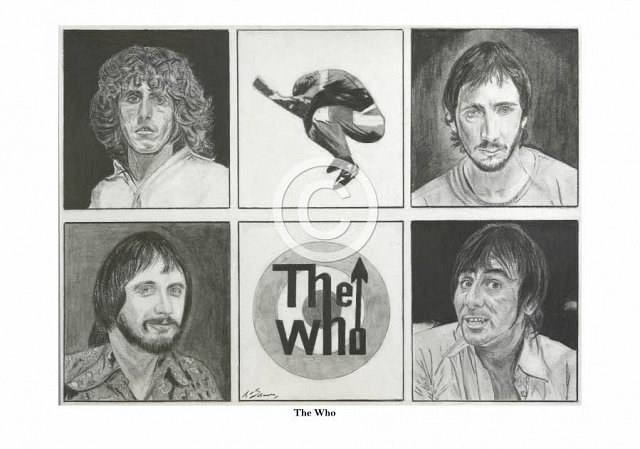The Who
Pencil Portrait by Antonio Bosano.

Shopping Basket
The quality of the prints are at a much higher level compared to the image shown on the left.
Order
A2 Pencil Print-Price £60-Purchase
*Limited edition run of 250 prints only*
All Pencil Prints are printed on the finest Bockingford Somerset Velvet 255 gsm paper.
P&P is not included in the above prices.

Recommended listening
Who's Next (1971)
Sublime ‘driving rage’ music to ‘tear the road up’ with, unless of course you’re on nine speeding points in which case some alternative listening experience is recommended. Windmilling at seventy miles an hour is also not recommended, but the temptation’s there when Townsend’s slash chords kick start ‘Won’t Get Fooled Again.’ Still – resist if you can, after all, you’ll live longer!
Thankfully ditching another ‘futuristic rock opera’ idea, the band would refocus on an alternate form of musical cohesion, randomly recording songs that would ultimately blow away critics and fans alike, bar a few Who diehards and tossers who couldn’t signpost a future musical direction in which synthesizers and modified keyboards would play such an integral part. Shit, the album even sports a cracking cover, picturing the foursome fresh from pissing on a slagheap.
Moonie’s all over the place with his fills, Entwhistle’s bass is thunderous, and Daltrey’s larynx shredding vocals soar above Townsend’s metallic riffing. It’s ‘testoterone rock’ at its most grandiose. ‘Baba O’Riley’ makes a spectacular opener, its hypnotic drone disrupted by power chords that are parachuted in off the backs of meteorites. Dave Arbus’ subtle then frantic viola solo raises it another gear. Great songs abound – ‘The Song is Over,’ ‘ Getting in Tune,’ and ‘Going Mobile,’ – and best of all, there’s ‘Behind Blue Eyes,’ a soul-searching ballad intercut with a majestic twin tracked guitar solo from Pete.
They sure as hell got it right here.
The Who by numbers (1975)
A rather overlooked work, “The Who by numbers” was another non-rock operatic release by the band, and all the better for it. This album and “Who’s Next,” are personal favourites of mine, a reminder that the idea of ten seemingly unconnected songs can still work cohesively, provided the unifying elements – lyrical themes, musical and production style etc- coalesce in a listener engaging manner.
Whilst the older generation missed the obvious sexual innuendo on “Squeeze box” – Townsend’s jaunty banjo-esque ditty is certainly no homage to a female accordionist!! – there’s enough thought provoking material for all ages to reflect upon. Cue “How Many Friends,” Townsend’s paean to self doubt and the notion of true friendship. Daltry redeems himself vocally with a superb delivery, switching effortlessly between soft, heartfelt singing in the verses, and the more bombastic chorus. Pete’s power chords* add gravitas to the sentiments of the song.
*Guitarists use power chords — built on the lowest notes of a regular open-position or barre chord — in rock music to create a low sound. Power chords are easier to play than are their full-version counterparts and don’t contain a major or minor quality to them, so they can stand in for either type of chord. Playing through a high powered amp can create unwanted dissonant frequencies if the third in the scale is additionally fretted, hence the use of only two notes five whole steps apart. Often referred to as 5 chords, Townsend has made stellar use of this stylistic devoice for years.
Under construction.
Shopping Basket
The quality of the prints are at a much higher level compared to the image shown on the left.
Order
A2 Pencil Print-Price £60-Purchase
*Limited edition run of 250 prints only*
All Pencil Prints are printed on the finest Bockingford Somerset Velvet 255 gsm paper.
P&P is not included in the above prices.


Comments
It should have been a night to savour: December 3, 1979 – The Who, seemingly resurrected after the death of Keith Moon, live in concert at the Riverside Coliseum, Cincinnati, yet by the end of the evening, events would signal the end of ‘festival seating’.
The origin of the disaster in which eleven fans, aged between 15 and 27 would die, could be traced in part to the practice of general-admission seating, as some 7,000 concert-goers rushed to secure first-come, first-served spots at the edge of the stage. As many as 14,770 of these so-called festival-style tickets had been sold for the Cincinnati performance at $10 each, with just over 3,575 reserved seats. There were also too-few doors and too-few ticket takers to handle the sudden influx of fans. Others, including the local WCPO-TV station, quickly cited drug use among the waiting throng, with some overdoses reported.
Despite these early deaths and fearing a riot, the newly installed Cincinnati Mayor Ken Blackwell, decreed that the evening concert should proceed. Neither Pete Townshend nor Roger Daltrey were reportedly told of the horrific events that had unfolded just outside until after their main set was completed. The band memebers, quite understandably, were devastated.
A Riverside tragedy was waiting to happen – a similar situation having ocurred just over three years earlier at an Elton John concert. A 1976 item from the Cincinnati Enquirer quoted fire captain James Gamm as expressing deep concerns over the practice of festival seating — adding that he feared bodies could “pile up in a major catastrophe.” Thereafter, first-come, first-served ticket sales would be banned in Cincinnati, even as 33 lawsuits piled up. All were reportedly settled by July 1984 according to the Enquirer, yet no criminal charges were ever filed.
Townshend can still barely reflect on the night, his 2012 sparse autobiographical recollections littered with distortions and factual inaccuracies. One suspects he’s still suffering.
http://www.crowdsafe.com/new.asp?ID=2182